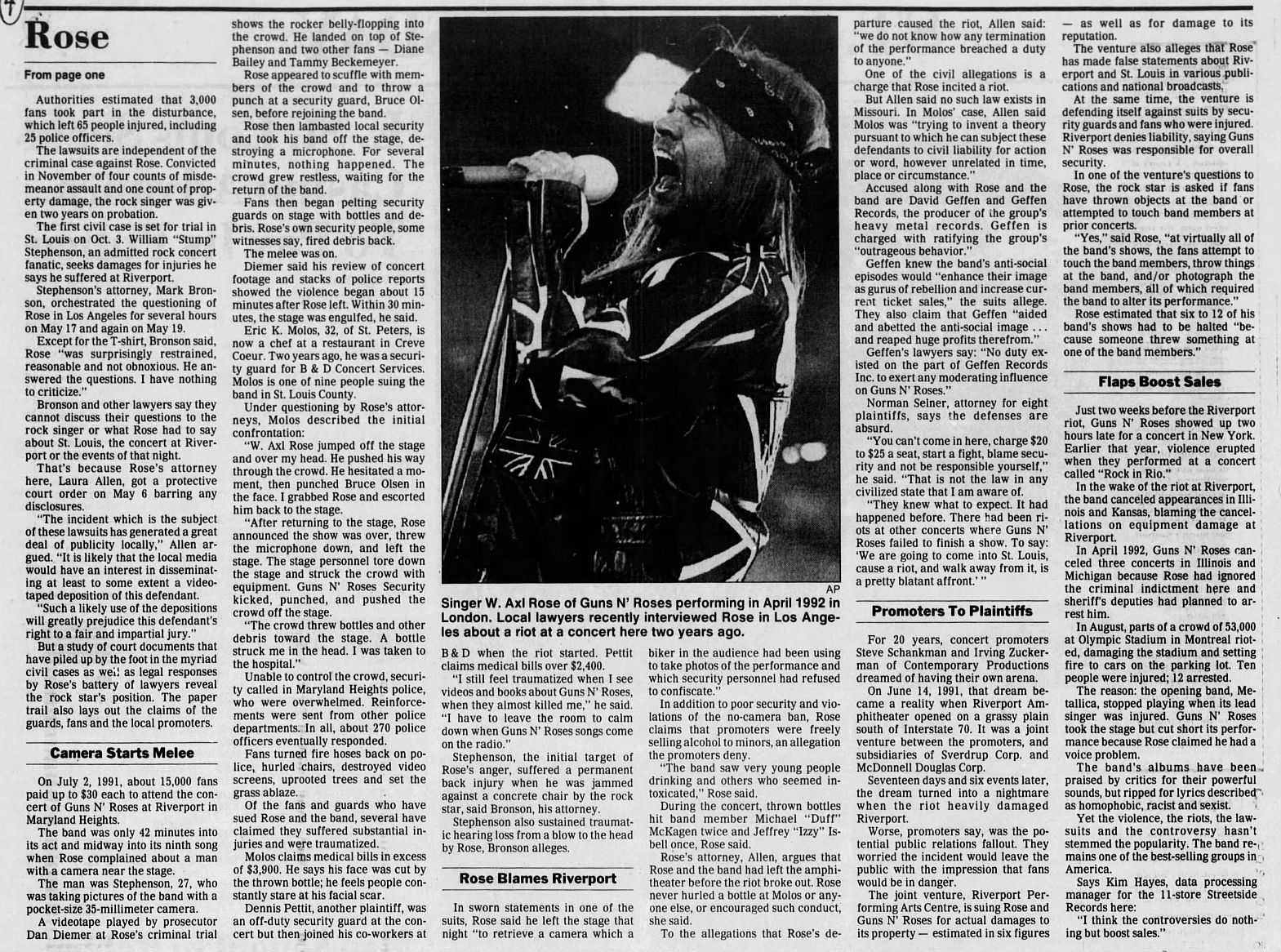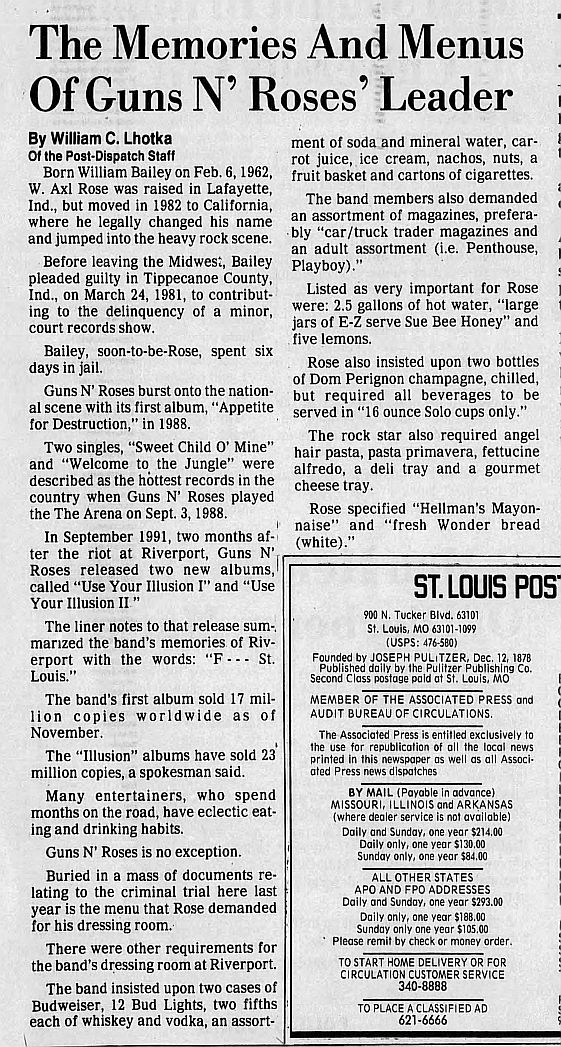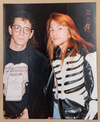1993.06.01 - The St. Louis Post-Dispatch - Axl’s Day In Court, Album 2
Page 1 of 1
 1993.06.01 - The St. Louis Post-Dispatch - Axl’s Day In Court, Album 2
1993.06.01 - The St. Louis Post-Dispatch - Axl’s Day In Court, Album 2



TRANSCRIPTION:
------------------------
Axl’s Day In Court, Album 2
Civil Suit Papers Detail 1991 Riot
By William C. Lhotka
Of the Post-Dispatch Staff
When a half-dozen St. Louis lawyers descended upon Los Angeles two weeks ago to question rock star W. Axl Rose about his role in the Riverport riot two years ago, they were stood up for six days.
Finally showing up for his videotaped questioning, Rose had a message for the lawyers.
The heavy metal star wore a T-shirt that said: "St. Louis S- - -
Rose; his band, Guns Ν' Roses; his corporate entity, Mo-gobo Inc.; and his producer, Geffen Records Inc., are being sued in St. Louis and St. Louis County Circuit Courts for injuries to security guards and spectators.
If that weren’t heavy enough, Rose is also being sued for damage to the Riverport Amphitheater in Maryland Heights. At the peak of the riot, even the grass was set on fire.
Authorities estimated that 3,000 fans took part in the disturbance, which left 65 people injured, including 25 police officers.
The lawsuits are independent of the criminal case against Rose. Convicted in November of four counts of misdemeanor assault and one count of property damage, the rock singer was given two years on probation.
The first civil case is set for trial in St. Louis on Oct. 3. William "Stump" Stephenson, an admitted rock concert fanatic, seeks damages for injuries he says he suffered at Riverport.
Stephenson's attorney, Mark Bronson, orchestrated the questioning of Rose in Los Angeles for several hours on May 17 and again on May 19.
Except for the T-shirt, Bronson said, Rose "was surprisingly restrained, reasonable and not obnoxious. He answered the questions. I have nothing to criticize."
Bronson and other lawyers say they cannot discuss their questions to the rock singer or what Rose had to say about St. Louis, the concert at River-port or the events of that night.
That's because Rose's attorney here, Laura Allen, got a protective court order on May 6 barring any disclosures.
“The incident which is the subject of these lawsuits has generated a great deal of publicity locally," Allen argued. “It is likely that the local media would have an interest in disseminating at least to some extent a videotaped deposition of this defendant.
"Such a likely use of the depositions will greatly prejudice this defendant's right to a fair and impartial jury.”
But a study of court documents that have piled up by the foot in the myriad civil cases as well as legal responses by Rose’s battery of lawyers reveal the rock star's position. The paper trail also lays out the claims of the guards, fans and the local promoters.
Camera Starts Melee
On July 2, 1991, about 15,000 fans paid up to $30 each to attend the concert of Guns N’ Roses at Riverport in Maryland Heights.
The band was only 42 minutes into its act and midway into its ninth song when Rose complained about a man with a camera near the stage.
The man was Stephenson, 27, who was taking pictures of the band with a pocket-size 35-millimeter camera.
A videotape played by prosecutor Dan Diemer at Rose's criminal trial shows the rocker belly-flopping into the crowd. He landed on top of Stephenson and two other fans — Diane Bailey and Tammy Beckemeyer.
Rose appeared to scuffle with members of the crowd and to throw a punch at a security guard. Bruce Olsen, before rejoining the band.
Rose then lambasted local security and took his band off the stage, destroying a microphone. For several minutes, nothing happened. The crowd grew restless, waiting for the return of the band.
Fans then began pelting security guards on stage with bottles and debris. Rose's own security people, some witnesses say, fired debris back.
The melee was on.
Diemer said his review of concert footage and stacks of police reports showed the violence began about 15 minutes after Rose left. Within 30 minutes, the stage was engulfed, he said.
Eric K. Molos, 32, of St. Peters, is now a chef at a restaurant in Creve Coeur. Two years ago, he was a security guard for B & D Concert Services. Molos is one of nine people suing the band in St. Louis County.
Under questioning by Rose’s attorneys, Molos described the initial confrontation:
“W. Axl Rose jumped off the stage and over my head. He pushed his way through the crowd. He hesitated a moment, then punched Bruce Olsen in the face. I grabbed Rose and escorted him back to the stage.
"After returning to the stage, Rose announced the show was over, threw the microphone down, and left the stage. The stage personnel tore down the stage and struck the crowd with equipment. Guns N’ Roses Security kicked, punched, and pushed the crowd off the stage.
"The crowd threw bottles and other debris toward the stage. A bottle struck me in the head. I was taken to the hospital."
Unable to control the crowd, security called in Maryland Heights police, who were overwhelmed. Reinforcements were sent from other police departments. In all, about 270 police officers eventually responded.
Fans turned fire hoses back on police, hurled chairs, destroyed video screens, uprooted trees and set the grass ablaze.
Of the fans and guards who have sued Rose and the band, several have claimed they suffered substantial injuries and were traumatized.
Molos claims medical bills in excess of $3,900. He says his face was cut by the thrown bottle; he feels people constantly stare at his facial scar.
Dennis Pettit, another plaintiff, was an off-duty security guard at the concert but then joined his co-workers at B&D when the riot started. Pettit claims medical bills over $2,400.
"I still feel traumatized when I see videos and books about Guns Ν' Roses, when they almost killed me," he said. "I have to leave the room to calm down when Guns Ν' Roses songs come on the radio."
Stephenson, the initial target of Rose's anger, suffered a permanent back injury when he was jammed against a concrete chair by the rock star, said Bronson, his attorney.
Stephenson also sustained traumatic hearing loss from a blow to the head by Rose, Bronson alleges.
Rose Blames Riverport
In sworn statements in one of the suits, Rose said he left the stage that night "to retrieve a camera which a biker in the audience had been using to take photos of the performance and which security personnel had refused to confiscate."
In addition to poor security and violations of the no-camera ban, Rose claims that promoters were freely selling alcohol to minors, an allegation the promoters deny.
"The band saw very young people drinking and others who seemed intoxicated," Rose said.
During the concert, thrown bottles hit band member Michael “Duff" McKagen twice and Jeffrey "Izzy" Isbell once, Rose said.
Rose's attorney, Allen, argues that Rose and the band had left the amphitheater before the riot broke out. Rose never hurled a bottle at Molos or anyone else, or encouraged such conduct, she said.
To the allegations that Rose's departure caused the riot, Allen said: "we do not know how any termination of the performance breached a duty to anyone."
One of the civil allegations is a charge that Rose incited a riot.
But Allen said no such law exists in Missouri. In Molos' case, Allen said Molos was "trying to invent a theory pursuant to which he can subject these defendants to civil liability for action or word, however unrelated in time, place or circumstance.”
Accused along with Rose and the band are David Geffen and Geffen Records, the producer of the group’s heavy metal records. Geffen is charged with ratifying the group’s "outrageous behavior."
Geffen knew the band's anti-social episodes would “enhance their image as gurus of rebellion and increase current ticket sales," the suits allege. They also claim that Geffen “aided and abetted the anti-social image ... and reaped huge profits therefrom.”
Geffen's lawyers say: “No duty existed on the part of Geffen Records Inc. to exert any moderating influence on Guns N’ Roses."
Norman Seiner, attorney for eight plaintiffs, says the defenses are absurd.
"You can’t come in here, charge $20 to $25 a seat, start a fight, blame security and not be responsible yourself," he said. "That is not the law in any civilized state that I am aware of.
"They knew what to expect. It had happened before. There had been riots at other concerts where Guns Ν' Roses failed to finish a show. To say: 'We are going to come into St. Louis, cause a riot, and walk away from it, is a pretty blatant affront.'"
Promoters To Plaintiffs
For 20 years, concert promoters Steve Schankman and Irving Zucker-man of Contemporary Productions dreamed of having their own arena.
On June 14, 1991, that dream became a reality when Riverport Amphitheater opened on a grassy plain south of Interstate 70. It was a joint venture between the promoters, and subsidiaries of Sverdrup Corp. and McDonnell Douglas Corp.
Seventeen days and six events later, the dream turned into a nightmare when the riot heavily damaged Riverport.
Worse, promoters say, was the potential public relations fallout. They worried the incident would leave the public with the impression that fans would be in danger.
The joint venture, Riverport Performing Arts Centre, is suing Rose and Guns Ν' Roses for actual damages to its property — estimated in six figures — as well as for damage to its reputation.
The venture also alleges that Rose has made false statements about Riverport and St. Louis in various publications and national broadcasts.
At the same time, the venture is defending itself against suits by security guards and fans who were injured. Riverport denies liability, saying Guns Ν' Roses was responsible for overall security.
In one of the venture's questions to Rose, the rock star is asked if fans have thrown objects at the band or attempted to touch band members at prior concerts.
“Yes," said Rose, "at virtually all of the band’s shows, the fans attempt to touch the band members, throw things at the band, and/or photograph the band members, all of which required the band to alter its performance."
Rose estimated that six to 12 of his band's shows had to be halted “because someone threw something at one of the band members."
Flaps Boost Sales
Just two weeks before the Riverport riot, Guns N’ Roses showed up two hours late for a concert in New York. Earlier that year, violence erupted when they performed at a concert called “Rock in Rio."
In the wake of the riot at Riverport, the band canceled appearances in Illinois and Kansas, blaming the cancellations on equipment damage at Riverport.
In April 1992, Guns Ν' Roses canceled three concerts in Illinois and Michigan because Rose had ignored the criminal indictment here and sheriffs deputies had planned to arrest him.
In August, parts of a crowd of 53,000 at Olympic Stadium in Montreal rioted, damaging the stadium and setting fire to cars on the parking lot. Ten people were injured; 12 arrested.
The reason: the opening band, Metallica, stopped playing when its lead singer was injured. Guns Ν' Roses took the stage but cut short its performance because Rose claimed he had a voice problem.
The band’s albums have been praised by critics for their powerful sounds, but ripped for lyrics described as homophobic, racist and sexist.
Yet the violence, the riots, the lawsuits and the controversy hasn’t stemmed the popularity. The band remains one of the best-selling groups in America.
Says Kim Hayes, data processing manager for the 11-store Streetside Records here:
“I think the controversies do nothing but boost sales."
Caption: AP Singer W. Axl Rose of Guns N’ Roses performing in April 1992 in London. Local lawyers recently interviewed Rose in Los Angeles about a riot at a concert here two years ago.
------------
The Memories And Menus Of Guns N' Roses Leader
By William C. Lhotka
Of the Post-Dispatch Staff
Born William Bailey on Feb. 6, 1962, W. Axl Rose was raised in Lafayette, Ind., but moved in 1982 to California, where he legally changed his name and jumped into the heavy rock scene.
Before leaving the Midwest, Bailey pleaded guilty in Tippecanoe County, Ind., on March 24, 1981, to contributing to the delinquency of a minor, court records show.
Bailey, soon-to-be-Rose, spent six days in jail.
Guns N’ Roses burst onto the national scene with its first album, “Appetite for Destruction,” in 1988.
Two singles, “Sweet Child O’ Mine” and “Welcome to the Jungle” were described as the hottest records in the country when Guns N’ Roses played the The Arena on Sept. 3, 1988.
In September 1991, two months after the riot at Riverport, Guns N’ Roses released two new albums, called “Use Your Illusion I” and “Use Your Illusion II.”
The liner notes to that release summarized the band’s memories of Riverport with the words: “F — St. Louis.”
The band’s first album sold 17 million copies worldwide as of November.
The "Illusion” albums have sold 23 million copies, a spokesman said.
Many entertainers, who spend months on the road, have eclectic eating and drinking habits.
Guns N’ Roses is no exception.
Buried in a mass of documents relating to the criminal trial here last year is the menu that Rose demanded for his dressing room.
There were other requirements for the band’s dressing room at Riverport.
The band insisted upon two cases of Budweiser, 12 Bud Lights, two fifths each of whiskey and vodka, an assortment of soda and mineral water, carrot juice, ice cream, nachos, nuts, a fruit basket and cartons of cigarettes.
The band members also demanded an assortment of magazines, preferably “car/truck trader magazines and an adult assortment (i.e. Penthouse, Playboy).”
Listed as very important for Rose were: 2.5 gallons of hot water, “large jars of E-Z serve Sue Bee Honey” and five lemons.
Rose also insisted upon two bottles of Dom Perignon champagne, chilled, but required all beverages to be served in “16 ounce Solo cups only.”
The rock star also required angel hair pasta, pasta primavera, fettucine alfredo, a deli tray and a gourmet cheese tray.
Rose specified “Hellman’s Mayonnaise” and “fresh Wonder bread (white).”

Blackstar- ADMIN
- Posts : 13902
Plectra : 91332
Reputation : 101
Join date : 2018-03-17
 Similar topics
Similar topics» 1993.10.15-29 - The St. Louis Post-Dispatch/AP - Reports (Civil suit trial) (Axl)
» 2020.08.07 - St. Louis Post-Dispatch - St. Louisan Richard Fortus calls producing new Psychedelic Furs album a labor of love
» 2017.07.20 - St. Louis Post-Dispatch - Back To The Jungle: Guns N' Roses Returns with St. Louis Guitarist Richard Fortus
» 1991.07.04 - The St. Louis Post-Dispatch - Bad Vibes
» 1991.07.09-12 - The St. Louis Post-Dispatch - Various reports (lawsuits)
» 2020.08.07 - St. Louis Post-Dispatch - St. Louisan Richard Fortus calls producing new Psychedelic Furs album a labor of love
» 2017.07.20 - St. Louis Post-Dispatch - Back To The Jungle: Guns N' Roses Returns with St. Louis Guitarist Richard Fortus
» 1991.07.04 - The St. Louis Post-Dispatch - Bad Vibes
» 1991.07.09-12 - The St. Louis Post-Dispatch - Various reports (lawsuits)
Page 1 of 1
Permissions in this forum:
You cannot reply to topics in this forum
